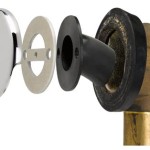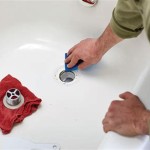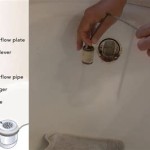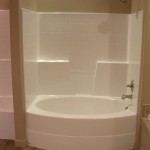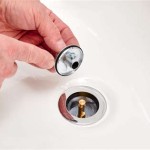How to Unclog a Bathtub with a Snake
A clogged bathtub drain is a common household problem that can range from a minor inconvenience to a major plumbing emergency. The primary culprits are typically hair, soap scum, and other debris that accumulate over time, restricting water flow and eventually causing a complete blockage. While chemical drain cleaners may offer a quick fix, they often contain harsh chemicals that can damage pipes and pose environmental risks. A more effective and environmentally friendly solution is to utilize a plumbing snake, sometimes referred to as a drain snake or auger. This tool physically breaks up and removes the clog, restoring proper drainage.
Effectively using a plumbing snake requires understanding the tool's mechanics and following specific steps to navigate the drain system. The process may involve some trial and error, but with patience and persistence, most bathtub clogs can be successfully removed using this method. Before beginning, it is crucial to gather the necessary tools and materials and protect the surrounding area to prevent messes and potential damage.
Preparing to Unclog the Drain
Before attempting to unclog the bathtub drain with a plumbing snake, careful preparation is essential to ensure both safety and efficiency. This involves gathering the necessary tools, protecting the surrounding area, and assessing the situation to understand the likely cause and location of the clog.
The primary tool required is, of course, the plumbing snake itself. Plumbing snakes come in various sizes and designs, ranging from small, hand-cranked models suitable for simple clogs to larger, more robust versions powered by electricity. For a typical bathtub clog, a hand-cranked snake is usually sufficient. Additionally, it’s beneficial to have a pair of rubber gloves to protect hands from grime and bacteria. A small bucket or container is also needed to collect any debris that is pulled out of the drain. A flashlight can be helpful for visually inspecting the drain opening.
Protecting the surrounding area is crucial to prevent messes during the unclogging process. Place old towels or rags around the drain opening to catch any splashing water or dislodged debris. This will help protect the bathtub surface and prevent the spread of potentially unsanitary materials. It is also advisable to wear old clothes or a work apron to avoid staining clothing.
Prior to inserting the plumbing snake, examine the drain opening for any visible obstructions. Sometimes, a large clump of hair or soap scum is easily accessible and can be removed by hand or with a pair of tweezers. If the drain has a stopper, remove it carefully. Some stoppers can be lifted out, while others may require unscrewing or other specialized methods. Consult the bathtub's manual or online resources for specific instructions on removing the stopper without causing damage. Understanding the likely cause and location of the clog can help guide the snaking process. If water is draining slowly, the clog is likely located further down the drainpipe. If the drain is completely blocked, the obstruction is likely closer to the drain opening.
The Process of Snaking the Drain
With the preparation complete, the next step is to insert and maneuver the plumbing snake to break up and remove the clog. This requires a methodical approach, careful attention to feel, and patience in navigating the drain system.
Begin by carefully inserting the end of the plumbing snake into the drain opening. Feed the snake slowly and steadily, avoiding excessive force that could damage the pipes. As the snake enters the drain, rotate the handle to help it navigate bends and curves in the piping. If the snake encounters resistance, do not force it. Instead, gently rotate the handle back and forth while applying slight pressure. This can help the snake to break through the obstruction or hook onto it.
Continue feeding the snake into the drainpipe until significant resistance is felt, indicating that the clog has been reached. Once the clog is encountered, rotate the handle of the snake to break up the obstruction. The rotation will cause the snake's head to grind against the clog, breaking it into smaller pieces that can be flushed away. It's also possible that the snake will hook onto the clog, allowing it to be pulled out of the drain. Continue rotating and pushing the snake until it feels like the clog has been sufficiently broken apart or hooked.
After working the snake against the clog, slowly retract it from the drainpipe. As the snake is pulled out, examine the end for any debris that has been pulled out with it. Dispose of this debris properly in a trash receptacle. If the snake comes out clean, it indicates that the clog has been broken apart but not removed. In this case, run hot water down the drain to flush away the remaining debris. Repeat the snaking process several times, if necessary, to ensure that the drain is completely clear. After each attempt, check the drainage by running water into the tub. If the water drains quickly and smoothly, the clog has been successfully removed. If the drainage is still slow, repeat the snaking process until the drain is completely clear.
Post-Snaking Procedures and Maintenance
Once the bathtub drain is unclogged, it is important to properly clean and maintain the drain to prevent future blockages. This includes flushing the drain thoroughly, cleaning the drain stopper, and implementing preventative measures to minimize the accumulation of hair and debris.
After the snake has been used to clear the clog, thoroughly flush the drain with hot water. Run the hot water for several minutes to ensure that any remaining debris is flushed away. This helps to clear the pipes and prevent any residual material from causing future blockages. If desired, a small amount of mild dish soap can be added to the hot water to help dissolve any remaining grease or soap scum. Avoid using harsh chemical drain cleaners, as they can damage the pipes and pose environmental risks. A natural enzymatic drain cleaner can be used periodically to help break down organic matter and prevent buildup.
The drain stopper is often a significant source of accumulated hair and debris. After unclogging the drain, remove the stopper and carefully clean it. Use a small brush or cloth to remove any hair, soap scum, or other debris that has accumulated on the stopper. Rinse the stopper thoroughly with clean water before reinstalling it. If the stopper is damaged or excessively worn, consider replacing it to ensure a proper seal and prevent debris from entering the drain.
Preventative maintenance is key to minimizing the risk of future bathtub clogs. Install a drain screen or strainer to catch hair and other debris before they enter the drainpipe. Clean the drain screen regularly, at least once a week, to prevent it from becoming clogged. Avoid pouring grease or oily substances down the drain, as they can solidify and contribute to blockages. Periodically flush the drain with hot water to help prevent the buildup of soap scum and other debris. Consider using a baking soda and vinegar solution to clean the drain every few months. Pour a cup of baking soda down the drain, followed by a cup of vinegar. Let the mixture fizz for 30 minutes, then flush with hot water. This can help to break down organic matter and keep the drain clear.
By following these steps, the bathtub drain can be effectively unclogged using a plumbing snake, and future blockages can be prevented. Regular maintenance and preventative measures are essential to keeping the drain clear and ensuring proper drainage.
When using a plumbing snake, it is essential to follow safety guidelines to prevent injury and damage to the plumbing. Always wear rubber gloves to protect hands from bacteria and grime. Avoid using excessive force, as this could damage the pipes. If the snake becomes stuck, do not pull on it forcefully. Instead, gently rotate it back and forth while applying slight pressure to try to dislodge it. If unable to remove the clog or encounter any difficulties, consult a professional plumber. A professional plumber has the expertise and equipment to handle more complex clogs and ensure that the plumbing system is not damaged.
Bathtub clogs are a common household problem that can be effectively resolved with the appropriate tools and techniques. The use of a plumbing snake provides a safe and environmentally friendly alternative to chemical drain cleaners. By following the steps outlined above, the bathtub drain can be successfully unclogged, and future blockages can be prevented.

How To Snake Out Clogged Bathtub Super Brothers Plumbing Heating Air

How To Clear A Clogged Bathtub Drain This Old House

How To Snake Out Clogged Bathtub Super Brothers Plumbing Heating Air
Bathtub Has Been Extremely Slow Draining Clogged For What Seems Like Years And All Methods We Ve Tried To Fix Draino Snakes Etc Are Inconsistent Any Permanent Solutions Quora

One Simple Trick To Unclog Your Tub Drain The Creek Line House

How To Snake Out A Bath Tub

How To Unclog A Drain With Snake

How To Unclog A Bathtub Drain Without Chemicals

Diy Solutions For Stubborn Bathtub Shower Drain Clogs

How To Snake Out A Bath Tub
Related Posts



